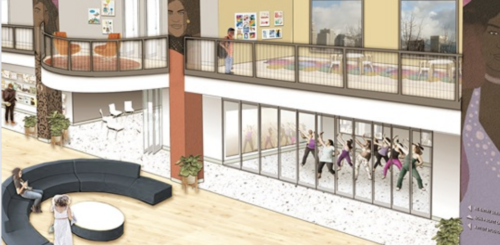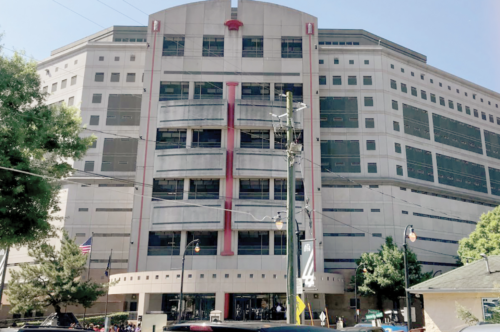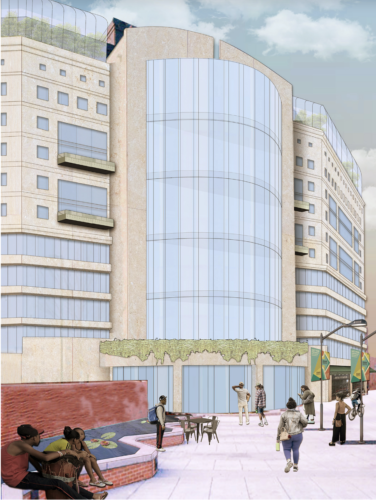
Community proposal includes a health and wellness center, a job training center, a mental health facility. Illustrations from Designing Justice + Designing Spaces.
https://www.yesmagazine.org/issue/world-we-want/2020/02/19/making-space-for-restorative-justice/
Some prosecutors and policymakers are beginning to work toward a legal system designed to benefit all people.
Over the past few years, statistics on how the U.S. justice system is failing its citizens have come fast and hard. With more than 2 million people detained in jails and prisons, we have the highest rate of incarceration in the world—a rate that’s increased 500% in the past five decades Possibly as many as 482,000 people currently held in local jails are there simply because they’re too poor to pay bail; they haven’t been convicted of a crime.
African Americans are three times more likely to be killed by police than White people, and Black men have a 1-in-3 chance of being imprisoned at some point in their lifetimes. And two-thirdsof those who’ve been incarcerated are rearrested within three years of their release.
Those numbers paint a picture of a justice system that’s anything but just—or effective. Rather than focusing on rehabilitation, our police, courts, and detention systems are aimed at retribution, particularly toward people of color; they harshly punish those who break the law instead of addressing the real reasons crimes occur, experts say.
But change is afoot. A wide range of justice-focused nonprofits, legal advocates, academics, and activists are developing and implementing concepts that, together, form a radically different vision of what crime and punishment could look like in the United States.
Re-visioning means thinking big, and these groups are working toward a wholly new framework: one that gives people and communities what they actually need. Instead of continued neglect, low-income communities get resources they’ve identified as priorities. In the place of Miranda warnings, plea deals, and prison cells are truth-telling, accountability, and forgiveness. And pain—which lies at the heart of so many of the crimes that currently wind up before the justice system—is met with love, transformation, and healing.
“The justice system is a hammer, and not everything is a nail. We don’t want to hammer people who use violence,” says sujatha baliga, who leads the Restorative Justice Project at the Bay Area-based organization Impact Justice. “I see the criminal legal system as a system of violence. We need to use nonviolence, in the Gandhian sense. It’s not passive: we’re actively working to end oppression.”

Atlanta closed its city jail, left, and is considering repurposing it as a center that benefits the people who suffered the most from unfair policies. Photo by Russell Terrell.
Restorative justice, which baliga teaches, leads, and advocates for, is a huge component of this new vision of justice. As a practice that facilitates conversation, restorative justice allows a crime survivor to explain what they need to make things right, and then holds the guilty party accountable for doing it. It’s a victim-centered process in which everyone is treated with dignity and no one ends up incarcerated.
So instead of wading through a court system that may never supply victims with a sense of closure, they gain understanding that allows them to forgive and begin to move forward. And instead of enduring a harsh punishment that’s disconnected from the actual reason the harm occurred, the person who’s responsible makes amends in whatever way is necessary—and in the process change a bit themselves.
Restorative justice has been gaining acceptance in youth settings, particularly as an alternative to traditional school discipline. But many advocates think it can be used much more broadly. “I think it can go all the way,” says baliga. “I think we can do all cases.” Not yet, of course; there’s a lot of capacity building that needs to happen within communities to learn how to constructively address conflict.
But already it’s being successfully applied to serious cases involving adults. For example, baliga and Impact Justice are utilizing restorative justice in situations of sexual assault and intimate partner violence, which tend to be more complex and deeply embedded than one-time offenses.
The New York City-based organization Common Justice is successfully using restorative justice for felonies—shootings, stabbings, gunpoint robberies—that would otherwise be tried in court. Instead of going before a judge and jury in a courtroom, cases are diverted to a process developed by Common Justice. “We’ve had powerful outcomes,” says Danielle Sered, Common Justice’s executive director. But serious crimes require a serious response; a restorative justice process in response to an attempted murder, for instance, might entail the guilty party spending more than a year closely participating in the organization’s violence reduction program while simultaneously performing public service as restitution to the person they harmed.
Both Common Justice and Impact Justice have cultivated relationships with local district attorneys who understand the merits of restorative justice and divert cases when they can. For the practice to grow, more prosecutors need to see the positive outcomes engendered by restorative justice. “If they measure success by safety or the satisfaction of crime victims, they’ll do this—even if they’re in the middle of a deep red state,” Sered says.
Ultimately, baliga’s vision is a network of restorative justice facilitators who can address issues as they occur, before the police have been alerted and anyone has been charged with a crime. “I’m imagining a world where there are restorative justice people in your neighborhood nearby,” baliga explains. “People will start walking in the door to resolve conflicts without ever calling the police.” That is, restorative justice could be used to circumvent—and starve—the current system.
Pain—which lies at the heart
of so many of the crimes that currently wind up
before the justice system—is met with love,
transformation, and healing.
Eventually, that could result in a drastic decrease in the size of local police forces, something else advocates for a better justice system are envisioning. Organizations around the country have been pushing for more accountability for the police, but many analysts and activists say that doesn’t go far enough to reduce the power of police and the damage they can cause low-income communities, particularly in Black and Brown neighborhoods.
“To my mind, [pressing for accountability] suggests more legitimizing the fact of police,” says Rachel Herzing, co-director of the Center for Political Education, a resource for progressive movements. She and others would like to see the eventual abolition of police forces, with the $100 billion that’s currently being spent on police across the country used instead for mental health services and other programs that can better address certain types of offenses—domestic violence, for example, or drug abuse—than the police can. Currently, those options aren’t on the table.
“If you look at any municipality in the country, half the general fund or more is dedicated to law enforcement, often,” Herzing says. “Community groups don’t have access to that level of resources or personnel—and also not the luxury of legitimacy, to try anything and fail. Whereas billions are going into containment and control, and haven’t eliminated harm.”
Activists in cities like Austin, Texas, Oakland, California, Durham, North Carolina, and Minneapolis have been taking advantage of police force contract renewals and budget negotiations to push for defunding departments and building community-focused solutions that don’t require militarized police.
In 2019, grassroots groups in Minneapolis were successful in getting $1 million reallocated from the police department budget to community-led efforts like violence reduction and legal services for immigrants.
Reducing police funding and scope of influence is an end in itself, but it’s also a means toward another big objective: abolishing prisons altogether.
After all, advocates say, there’s ample evidence that prisons don’t work: they themselves are dangerous places that lead inmates toward bad behavior, not away from it. “You don’t have to hate the confinement of people in cages to be a prison abolitionist,” says Sered. “You just have to hate violence.” People aren’t rehabilitated while incarcerated, and they usually leave with few options to create a better life for themselves—and many obstacles.
In response, abolitionists are fighting to stop prisons from being built or expanded, while simultaneously advocating against policies like cash bail and techniques like indefinite solitary confinement. They celebrated a big win in June 2019 when a proposed new federal prison in eastern Kentucky, which would have cost more than $500 million, was canceled, due in large part to local opposition. And in May 2019, the Atlanta city council agreed to close the city’s jail the result of years of broad-based organizing and policy changes initiated by activists.
But it’s impossible to talk about prison abolition without explaining what would replace the system. The answer to that lies in the numbers: $87 billion— the amount spent annually on public corrections agencies in the U.S.
“We’ve invested in police and prisons for too long. We need to shrink the footprint of this and invest in those things that are community-led,” says Amanda Alexander, founding executive director of the Detroit Justice Center.


Proposals, such as the one illustrated, include a health and wellness center, a job training center, or a mental health facility. Illustrations from Designing Justice + Designing Spaces.
What would the incarceration rate be if that $87 billion was directed toward job training, youth programs, schools, supportive housing, and mental health centers? Alexander’s organization has pointed out that the $533 million being spent on a new jail complex by Wayne County—Michigan’s most populous county, in which Detroit is located—could be used to house every homeless person in Detroit in hundred-thousand-dollar homes. “It’s really staggering,” Alexander says. “Instead, we’re investing in cages.”
Colorado is implementing an example of that new vision Alexander describes. In 2017, the state legislature passed a bill to reinvest $4 million of the state’s $1 billion corrections budget in community programs in two regions with some of the highest incarceration rates in the state, particularly for people of color. The funding is going toward grants for community organizations—with allocations determined by local planning teams—and small business lending, often to formerly incarcerated people.
“We don’t have to see the criminal justice system as the only system to provide safety. We’re saying that the community, especially the communities most impacted by crime and overpolicing and mass incarceration, have a powerful role to play,” says Christie Donner, executive director of the Colorado Criminal Justice Reform Coalition. Donner’s group wrote the original bill and shepherded it through the legislative process. The initiative is meant to be an entirely new model. “Our thinking is that we’re braiding two goals: Marshall Plan meets reparations.”
But one day, when all these people-centered programs succeed, what will happen to those empty prisons? Some organizations are already thinking about it. In North Carolina, the organization Growing Change employs young people who’ve been through the juvenile justice system to build an organic farm at an abandoned prison site.
And in Oakland, the architecture firm Designing Justice + Designing Spaces (DJDS) is creating structures that aim to address the root causes of incarceration. The firm recently developed the country’s first center for restorative justice and restorative economics—the latter is a system that prioritizes cooperation over exploitation—and is now working closely with Atlanta activists and policymakers to repurpose the city’s shuttered jail. The facility costs $33 million annually to run, and advocates would like to see much of that funding reinvested in a center that benefits the people who suffered the most from unfair policies.
Xochitl Bervera, director of Atlanta’s Racial Justice Action Center, says they’ve had a lot of conversations with DJDS about their vision for the center. “They helped us think bigger. So not just a social service building, but a multipurpose center that transforms the neighborhood, that’s life affirming,” Bervera explains.
It’s not a done deal; the city hasn’t yet decided whether it will award the Oakland firm the contract to develop the property. But at this point, the vision is a “center for wellness and freedom” that would offer residents one-stop shopping for employment, health care, and childcare assistance.
But DJDS didn’t just waltz into Atlanta from California with an idea for what the city’s residents needed. Instead, the company spent months hosting community meetings that utilized a range of engagement tools to solicit input from more than 400 Atlantans, including formerly incarcerated individuals, members of queer and trans communities, homeless people, and immigrants. Its designs came directly from them.
The project at times was contentious, says DJDS architectural associate Shelley Davis Roberts. After all, some people—bail bondsmen, corrections officers, facilities workers—lost their livelihoods when the jail closed, and many of them came from the same low-income communities as those who were incarcerated there. “So we felt it was very important to let people know that ‘we care about what you think; you’re the experts in the room,’” explains Roberts.
Transforming our current legal system in a way that humanizes instead of criminalizes people—all people—is a revolutionary action. One whose time has come.

